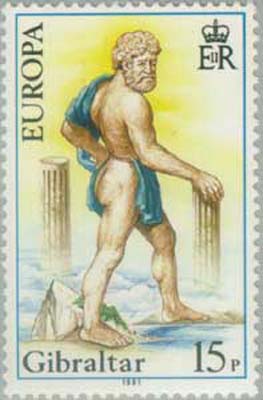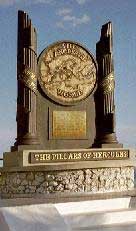.


Pillars of Hercules is the ancient name given to the promontories that flank the entrance to the Straits of Gibraltar. They are Gibraltar in Europe and Monte Hacho in Ceuta in Africa. The Jebel Musa, west of Ceuta, is sometimes considered one of the Pillars.
Mythological significance
The creation of the pillars
After killing Medusa, Perseus took the head of the Gorgon with him to distant lands and reached the western end of the Earth where the sun sets - the land where Atlas the Titan resided and raised magical golden apples. Perseus wished to rest in Atlas' garden and asked him for food but Atlas - fearing that the hero would steal his magical fruit - refused and sent Perseus away. Perseus then showed Atlas the head of Medusa and the Titan turned into a giant mountain - his hair turning into a great forest, his shoulders into cliffs and his bones into solid rock.
The naming of the pillars
When Hercules had to perform twelve labours, one of them was to fetch the Cattle of Geryon and bring it to Eurystheus. On his way to the island of Erytheia he had to cross the mountain that was once Atlas. Instead of climbing the great mountain, Hercules split it in half using his indestructible mace. By doing so, he connected the Atlantic Ocean to the Mediterranean Sea and formed the Strait of Gibraltar. One part of the split mountain is currently called Gibraltar and the other is Monte Hacho. These two mountains taken together were since then known as the Pillars of Hercules.
The pillars as portals

Spanish coat of arms
The pillars are also mentioned at some places as portals, or gates to different locations on Earth. When the Carthaginian admiral Himilco was sent to explore the area of the Muddy Sea (a shallow plateau that lies to the southwest of the Pillars) his report included the words "Many seaweeds grow in the troughs between the waves, which slow the ship like bushes {...} Here the beasts of the sea move slowly hither and thither, and great monsters swim languidly among the sluggishly creeping ships" (Rufus Festus Avienus) This description accurately resembles the Sargasso Sea rather than the Muddy Sea.
The Pillars appear as supporters of the coat of arms of Spain. The motto Plus Ultra (Latin for further beyond) indicates the desire to see the Pillars as an entrance to the rest of the world rather than as a gate to the Mediterranean Sea.
But is was not until Columbus discovered America in 1492 that it became Plus Ultra, before this point it said Non Plus Ultra. The reason for this was that until then the navigation outside of the pillars had been limited to coastline navigation. It wasn't until Columbus' discovery that seafaring technology proved to be ripe enough for sailors to venture "safely" into the open ocean.

The Pillars of Hercules Monument at Jews' Gate, Gibraltar
Phoenician connection
Another origin for the legend could be the columns of the Phoenician temple of Melqart at Gadir, just beyond the Strait. Melqart was identified by the Greeks with Heracles. The columns of the Melqart temple at Tyros were also of religious significance.
Historical location
Before Eratosthenes about 250 BC, ancient Greek writers located the Pillars of Hercules on the Strait of Sicily. This changed with Alexander the Great’s eastward expansion and the Pillars were moved by Eratosthenes to Gibraltar. This evidence has been cited in some Atlantis theories, notably in Sergio Frau's.
In Dante's Inferno
When describing his circles of hell, Dante mentions Ulysses and his voyage past the Pillars of Hercules (once considered the western end of the world). Ulysses justifies endangering his sailors by the fact that his goal is to gain knowledge of the unknown. After five months of navigation in the ocean, Ulysses detects the Purgatory but encounters a whirlwind that sinks his ship.
In music
The Russian bard Alexander Gorodnitsky wrote a song under a similar title in 1965, while sailing past the Strait of Gibraltar on one of his many sea voyages. The song makes numerous references to Ulysses' voyages in the area and other sections of The Odyssey
See also : Greek Mythology. Paintings, Drawings
| Ancient Greece
Science, Technology , Medicine , Warfare, , Biographies , Life , Cities/Places/Maps , Arts , Literature , Philosophy ,Olympics, Mythology , History , Images Medieval Greece / Byzantine Empire Science, Technology, Arts, , Warfare , Literature, Biographies, Icons, History Modern Greece Cities, Islands, Regions, Fauna/Flora ,Biographies , History , Warfare, Science/Technology, Literature, Music , Arts , Film/Actors , Sport , Fashion --- |
Retrieved from "http://en.wikipedia.org"
All text is available under the terms of the GNU Free Documentation License

